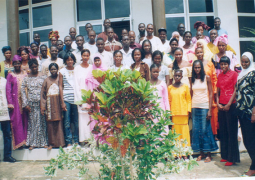
The Caliph General of Kaolack, Senegal, Sheikh Ahmad Tijan Ibrahim Niass, witnessed the laying of the foundation stone.
The VP laid the foundation stone on behalf of President Yahya Jammeh, in commemoration of The Gambia’s 50th independence anniversary.
The project is being financed by the African Development Fund (ADF) with a grant to the Gambia of Unit of Account UA 63.55 million equivalent to D4 billion, aimed at reinforcing the economic cooperation and integration between the Gambia and Senegal and ECOWAS community as a whole.
The project was officially signed on 11 November 2014, a contract awarded to two companies: JV Corsan Corvian of Spain and Arezki S. A. of Senegal, which is expected to last 36 months, according to the contract agreement.
Speaking at the ceremony, the Vice President said the construction of the bridge including other facilities was supposed to address the bottlenecks arising from the present mode of crossing the Gambia River by ferry.
The pre-stressed concrete bridge, which is 942 meters long, has half a kilometer of access road through the swamps on either of the river bank, she announced.
She added that to preserve the navigability of the river, a navigation channel of 70 meters wide and 16.5 meters high has been allowed for in the bridge design.
VP Njie-Saidy said the event also marked the beginning of the realization of one of the most complex yet socio-economically significant engineering undertakings in transport and physical infrastructure developments.
She said the Trans-Gambia corridor is an important economic and strategic link that connects the northern and southern parts of The Gambia and neighbouring Senegal, which serves both intra and interstate traffic.
Upon successful completion, she pointed out, the bridge is envisaged to allow the free flow of traffic between the north and south parts of both nations as part of Tran-West African Highway.
The project would also facilitate overland traffic flow in West Africa as a whole, thus enhancing regional integration.
In line with the ECOWAS protocols for trade and transport facilitation, VP Njie-Saidy said two joint-border posts would be constructed at Keur Ayib, Keur Ali and Amaissera Soneba, which would be in accordance with ECOWAS protocols and rules.
She added that the project would enhance the connectivity of the highway with its surroundings by building feeder roads in the enactment area, to facilitate access to such places as markets, hospitals and schools and to ease the transportation of agricultural products.
In his remarks on the occasion, Transport, Works and Infrastructure Minister, Balla Garba Jahumpa, said the presence of the Senegalese officials was an indication of the political will to witness the laying of foundation stone for the project.
Minister Jahumpa commended both presidents for the exhibition of their political will for the implementation of the project.
He said the history of the bridge dated way back in 1972, adding that since 1994, President Jammeh had embarked on numerous development projects for the nation, which had witnessed the erection of numerous bridges across the nation.
Senegalese Prime Minister Momodou Dionne, while delivering his statement, described the two nations as one people with the same culture.
He extended President Macky Sall’s congratulations to President Jammeh on the 50th independence anniversary, and for the construction of the bridge, which benefits not only the two nations, but also the continent as a whole.
He said the completion of the project would boost the economies of the two nations, as well as increase their productivity on various aspects.
A representative from the African Development Bank (ADB), Mamadou Lamine N’Dongo, congratulated The Gambia on the 50th independence anniversary.
He recalled that it was almost 30 years ago when the idea to connect the two banks with a bridge was conceptualised.
Mr N’Dongo said the project would connect the whole African continent, pointing out that the project is a visionary reflection of both heads of state for the benefit of the continent.
He said the construction of the bridge and one-stop border post facilities represent a major milestone and fulfillment of the ADB’s role in promoting regional integration through development of flagship infrastructure projects.
He signified regional integration as the only way to realize its growth potential and equitably share the benefits of an increasingly connected world marketplace.
Integration, he said, would enable nations on the continent gain benefits of larger markets thus improving the productive capacity of Africa’s economies.
He added that the project is set within the framework of regional programmes and NEPAD and the ECOWAS priority Road Transport Programme, and aligned with the ADB’s regional integration strategy for West Africa.
Muhammed Zioui and Gerardo Espinosa, the contractor and the consultant, promised to accomplish their contractual obligations in order to reach the planned targets regarding the quality, time and cost.
The Gambia hosted a signing ceremony on 11 November 2014 to kick-start the first phase of the $93 million Trans-Gambia Bridge project.
A
Spanish company Isolux-Corsan and its Senegalese partner Areski signed a
contract for the construction of a $64 million 942 meter bridge linking
Bambatenda andYellitenda ferry
terminals (near Farafenni) and two one-stop border posts on each side.


